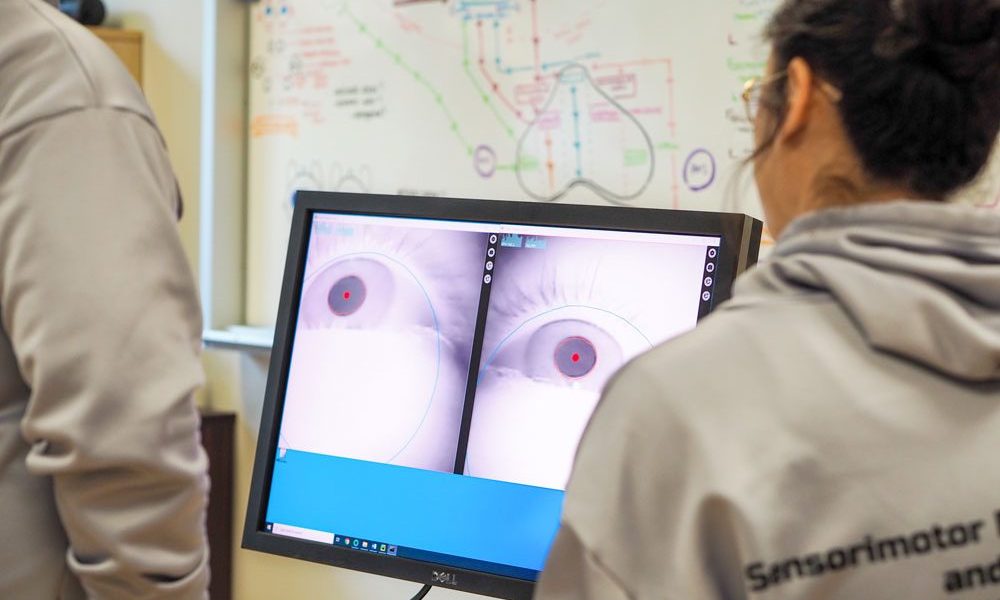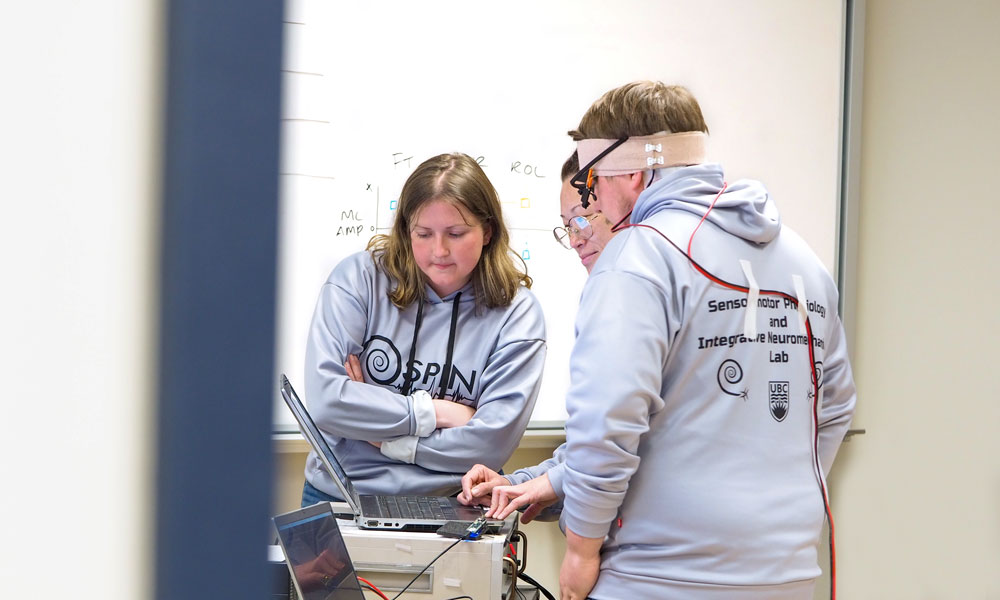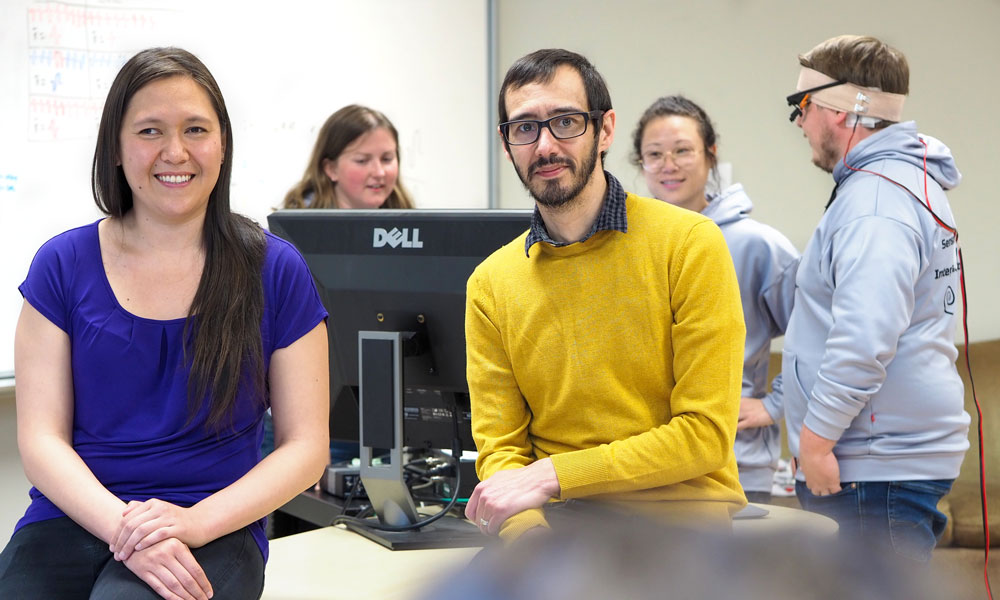
SOMEWHERE BETWEEN EIGHT AND 18 MONTHS, babies take their own small step for humankind—those first wobbly plods into a parent’s arms. This giant leap for their developing brains is still barely understood by science—a marvel of neurons and the nervous system that we usually take for granted throughout our lives.
But the final frontier of health science might just be our understanding of what maintains our balance as we age.
As a teen growing up in Newfoundland, Dr. Brian Dalton—now an Assistant Professor of neuromuscular physiology at UBC Okanagan’s School of Health and Exercise Sciences—noticed something happening to his grandmother Grace.
She lived with the Dalton family for years, and the two were close. But, beginning in her mid-60s, she swayed, stumbled and felt dizzy. She was losing her ability to stay upright.
At university, Dr. Dalton took a kinesiology elective that triggered memories of his grandmother and stoked a desire to discover why her mobility and balance faltered. When he joined UBCO in 2016—with a PhD in kinesiology and a postdoctoral fellowship under his belt—Dr. Dalton started the university’s SPIN (Sensorimotor Physiology and Integrative Neuromechanics) Lab.
The primary aim of the lab is to answer two questions: what exactly causes older adults to lose their sense of balance? And what can be done to stave off the erosion of that critical human function?
The importance of answering these questions is clear if one looks at national statistics or has an older parent or relative who keeps falling, fracturing arms and hips.
According to the most recent data compiled by the Canadian Institute for Health Information, falls accounted for 81 per cent of all injury-related hospitalizations for older Canadians in 2018. That same year, falls among those 65 and older killed 4,849 seniors and left another 28,310 with disabilities. The hospitalization rate associated with falls increased by four times among those aged 65 years and over, compared to those 45 to 64.

Students from the SPIN Lab track eye movements during vestibular (inner ear) balance disturbances. Here, researchers use electrical stimulation of the inner ear to evaluate the reflex that stabilizes our eyes while performing a standing balance task.
Questioning human balance
Though medical research has unveiled many mysteries about how the human body functions, it’s surprising to learn how little we know about something seemingly as basic as how humans stay upright.
Much of our understanding about human balance is still yet to be discovered, says Dr. Dalton. “Frankly, technologies are just getting to the point where we can look inside the brain and nerves to see what’s actually going on.”
At the SPIN Lab, Dr. Dalton currently directs a team of six, including PhD, master’s and undergraduate students. Much of their research focuses on understanding how aging mechanisms affect what are called “sensorimotor” signals in the cortical (outer layer) of the cerebrum—the largest part of our brains—as well as the inner ears’ vestibular system.
When the latter works properly, it sends signals to the brain about our posture and spatial orientation, in turn triggering reactions in our muscles to adjust balance. But, when vestibular hair cells and nerves degenerate with age, the signals to correct balance weaken and the risk of falls increases.
British Columbia and Newfoundland have the oldest populations in Canada. Kelowna, particularly, is home to a large seniors population, says Dr. Dalton. “Because of the lifestyle here, there are a lot of active older adults that can participate in our research. And because of Kelowna’s warmer climate as well, there are a lot of older adults who have moved here and have various movement disorders. So, we can focus those two populations for research.”
One technique Dr. Dalton uses in his lab research is called intramuscular electromyography. It can record activity in a given motor unit—the single motor nerve cell bundled with hundreds of others that direct the muscle actions of our bodies.
“We’re able to record signals from those single cells during standing balance tests, or during various movements, to answer some of these questions,” explains Dr. Dalton.
“The main thing I’m interested in is what factors allow us to perform standing balance, an activity many people just perform unnoticed. And then I want to know what’s happening to the nervous system with aging—the mechanisms and physiological processes, how do they change with age? Then, can we intervene to improve those factors to allow people to balance correctly and perform activities of daily living without limitations?”
The SPIN Lab recently made a discovery about older adults’ vestibular system. As the inner ear signals transmitting body position information to the brain deteriorate, older adults essentially “turn up the volume knob” on their reflexes. That, for example, can make them overcompensate their reflexes when a bus they’re standing in suddenly brakes.
“That was surprising to us,” says Dr. Dalton. Whether this is a good or a bad thing is yet to be determined.
Dr. Dalton has been collaborating with researchers from the University of Exeter in the UK and the University of Queensland in Australia on a pilot project investigating whether our sensorimotor signals can be adapted when wearing assistive technologies—exoskeletons—that assist movement and balance in people.

SPIN Lab students Paige Copeland, Lisa Ha and Matthew Debenham look at the eye movements recorded while testing how the inner ear works to steady our eyes while standing. The inner ear (or vestibular system) is important for both balance and stabilizing our gaze.
Getting a hand on it
Back at UBCO’s SPIN Lab, Dr. Dalton is also working with Dr. Vicki Komisar at the School of Engineering to identify more feasible and affordable ways to assist those with balance issues. As an Assistant Professor in mechanical engineering, Dr. Komisar researches fall injury and prevention by combining approaches from biomechanics, motor control, gerontology and other fields to make the world safer for people.
Take, for instance, the simple handrail.
Most handrails in homes and buildings are not at the ideal height—or shape, for that matter—for people with balance issues when they try to arrest a fall. In fact, for years, several Canadian design standards restricted handrail heights to between 34 and 38 inches in height above stair level.
But certain standards, such as WorkSafeBC’s guidance on fall prevention, were amended in part because research by Dr. Komisar and others demonstrated that 42 inches was ideal for fall prevention and recovery of older adults. Thinner, round handrails were also better for mobility.
Like Dr. Dalton, the inspiration for Dr. Komisar’s research career was propelled by her great grandmother, who lived in a Manhattan walk-up. “She was the type of person who, at the age of 92, would walk up and down six flights of stairs at her apartment because it didn’t have an elevator. She was in that kind of shape.”
One day, recounts Dr. Komisar, her grandmother bent down to pull up a sock, lost balance and toppled over, fracturing her hip. “She went to the hospital and she never returned. That had a profound impact on me.”

Dr. Vicki Komisar and Dr. Brian Dalton in the SPIN Lab.
Dr. Komisar and Dr. Dalton have ongoing collaborations, including the UBCO-supported Aging in Place research cluster, which helps support older adults maintain active living, independence and emotional health. “Brian is a titan of fundamental science in how the senses interact to control balance to help people avoid falls,” says Dr. Komisar.
She uses applied engineering to help translate fundamental scientific findings from researchers like Dr. Dalton into evidence-based guidelines in the design of fall prevention tools—which are often clever tweaks for furniture and other accessories common in households.
Often, as people get older, explains Dr. Komisar, they’ll grab furniture or countertops to prevent a fall. “As we age, we can think of our home setting as fundamental to assisting us in getting up and around. But very little thought has gone into how the design of these home features influence mobility and fall prevention.”
Studies show that when older adults fall at home and remain alone on a floor for over an hour, they are at higher risk for pressure sores, unintentional incontinence, and permanent entry into long-term care.
Dr. Komisar is building relationships with companies interested in creating specialized furniture—such as countertops with built-in handholds—that people can use to stop a fall or get up afterwards.
“I look at how we can build these devices seamlessly into the home by providing recommendations to furniture designers. It’s thinking of furniture and household appliances not only as something people use to sit on and do basic activities with, but ultimately recognizing that it’s going to double as a mobility aid eventually in somebody’s life span.”